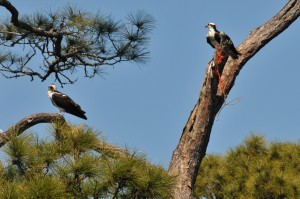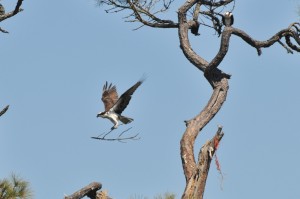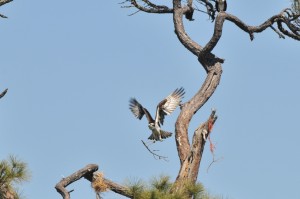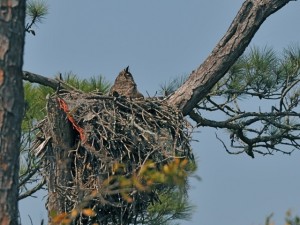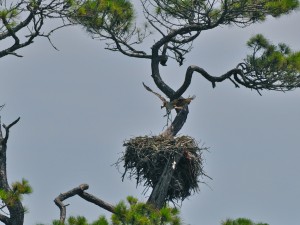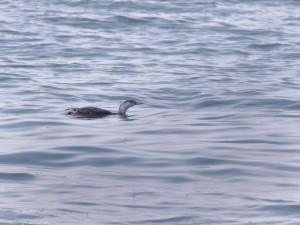The tide was far out and still receding as I walked further east on the beach, coming to a long, deep tidal pool that lay between me and the edge of the waves. Beyond it on a stretch of wet sand well above the waves sat two American Oystercatchers, conspicuous with their big bold patterns of black, brown and white, and long, bright, almost shimmering red-orange bills. Funny how they can look, at the same time, so comical and so regal. Though I watched for a while, they stayed settled down on the beach, not standing or moving around. Usually when I’ve seen Oystercatchers before, they’ve been both very active and vocal, but these were quiet. When I walked back by them later, they were still there in the same spot, contentedly settled, soaking up the warm morning sun.
Still further up the beach, the dunes on my left receded and I discovered a great spot. Beyond the ripple marks of high tide on the sand lay a large depression hiding a series of shallow tidal pools. In them and on the sand and muddy flats around them were dozens of shorebirds, and in the distance stretched islands of grasses and sand, and more dunes.
Dowitchers and Dunlins fed in the shallow water of the pools. Sanderlings, Willets and Semi-palmated Plovers foraged on the sand and edges of the water. Two Black-bellied Plovers – widely separated – each patrolled a stretch of sand. One Lesser Yellowlegs danced gracefully in water on the edge of a pool. Forster’s Terns fluttered like flashes of white light over the water, and two Ospreys flew over several times, back and forth from somewhere they were fishing. Among the grasses in the distance were a Snowy Egret, a Tri-colored Heron, and a Great Egret.
The two Black-bellied Plovers – relatively tall, long-legged plovers that stand erect, with head held high, were still mostly in grayish winter plumage, but were beginning to look a little more intensely black and white. A couple of times one flew up a short way and back, showing the black patch under the wings. Both spent most of their time trying to keep all of the other birds, especially the other plovers, off their stretches of sand – for the most part unsuccessfully. The smaller birds kept venturing back, and the Black-bellied Plovers spent more time chasing them away again than feeding.
The Dowitchers – plump, medium-size grayish sandpipers (in winter) with very long bills – kept their heads mostly down, often submerged, probing and feeding intently, though two or three paused very briefly to preen. I couldn’t figure out if they were long-billed or short-billed Dowitchers and never heard their calls – the only way I might have been able to tell for sure. My best guess is Short-billed, because they are said to be more likely on the beach, rather than in fresh water – but it’s only a guess.
The lone Lesser Yellowlegs – a slender sandpiper with long yellow legs – moved with quick, crisp movements, delicate and distinct, with a thin, spindly grace, an airiness about it – quite different from the more businesslike and stocky Dowitchers.
Shorebirds – especially all the sandpipers – are always a challenge to me, and just pure fun. It seems I have to learn half of them all over again every time I get to the beach or the marsh. But each time I see them, they become a little more familiar, and a little more of the different personality of each comes to life. They’re a little like sparrows – so much alike at first glance that it’s tempting not even to try, but then as you get to know them, so different you wonder why you didn’t see it to begin with.
As I headed back toward home, passing again the long tidal pool between me and the distant edge of the waves at low tide, an Osprey stood deep in the water of the pool, bathing. It sat there for minutes at a time, just looking around, in water halfway up its wings, now and then dunking its head and whole body, thrashing the wings – taking a good long leisurely bath. I tried to keep my distance and walk slowly, still thinking it would probably fly, but it didn’t seem disturbed at all and only left the water and flew, with a big swoosh and splash, when I was well past it.
